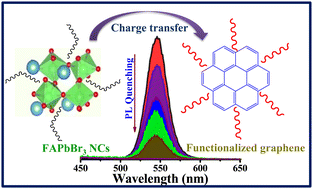Tuning charge transfer efficiency by functionalizing ligands in FAPbBr3 nanocrystals and graphene heterostructures†
Abstract
The combination of halide perovskite NCs with graphene to design heterostructures has proven to be a promising candidate for energy applications, optoelectronics, and photocatalysis. Efficient light energy absorption in perovskite NC-graphene heterostructures is of fundamental importance owing to their optoelectronic applications. A detailed understanding of the important process for device action, particularly interfacial charge transfer (CT), has thus far lingered subtly. This study describes the influence of the different surface functionalities of graphene on the CT dynamics in FAPbBr3 NCs attached to functionalized graphene heterostructures. Functionalized graphenes i.e., graphene oxide (GO) and amino acids (alanine (Ala), tyrosine (Tyr) and cysteine (Cys)) functionalized GO, were synthesized. By assembling the heterostructures of functionalized graphene with NCs, the quenching of photoluminescence (PL) of the FAPbBr3 NCs was observed. The photo-generated hole transfer from FAPbBr3 to functionalized graphene is responsible for PL quenching, which is supported by time-resolved photoluminescence (TRPL) and cyclic voltammetry (CV) analysis. Our study revealed that the rate of CT and charge transfer efficiency (ECT) strongly depend on the nature of the functionalizing moieties. The highest hole transfer efficiency for NC-functionalized graphene heterostructures was observed in the case of cysteine-functionalized GO (88.84%) and the lowest with GO (38.15%). This suggests that cysteine-functionalized graphene is the best hole acceptor amongst all functionalized graphenes. This study offers a method to regulate energetics and investigate the extent of hole transfer in perovskite NCs and functionalized graphene heterostructures. These findings tend to draw new directions to stimulate advance research regarding the fundamental understanding of hole transfer in surface-modified donor–acceptor heterostructures for light harvesting assemblies, especially solar cells.



 Please wait while we load your content...
Please wait while we load your content...